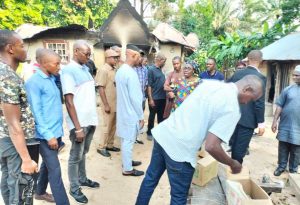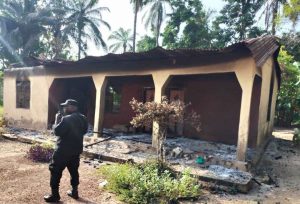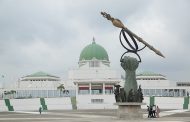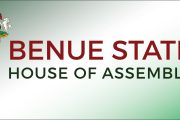Fourteen (14) of the identified dead bodies in the mercenary attack on Igama Village in lower part of Edemoga District, Okpokwu LGA of Benue State in central Nigeria went down several inches Friday, June 18th, 2022 in the area. That was happening on the same day that the Benue State Police Command was also speaking to the aftermath of the violence that claimed their lives by revealing that it now has four of the over 100 mercenaries suspected to have participated in the act.

Engineer Abounu in blue kaftan and Osinbajo-style cap in Igama Village
There was a relatively scanty presence of political leaders in the burial which speaks to the heavy rains around the area at this time that prevented many from making it as well as the relative underdevelopment of the area, with particular reference to the road network and the impassable “monkey bridges” that populate the area. It was assumed though that Governor Samuel Ortom, generally referred to as “the defender of the Benue Valley” would put up a symbolic presence. Alas, he didn’t but his deputy, Engineer Benson Abounu, was there the following day, June 13th, 2022.
It would be recalled that the contestation over access to land between herders and farming communities in Benue State of Nigeria took a rather extra-ordinarily violent turn early morning June 12th, 2022. An early morning attack on the agrarian community of Igama not only left eleven persons dead but a better part of the entire community burnt down. Three more bodies were discovered later.

Burnt out
Unsuspecting eye-witnesses had sighted men on motorcycles early that morning but did not think of an operation on such a scale. By 7 am, it was all over. Although the first set of security operatives who rushed in response to distress alarms from the village still caught the tail end of the operation, they too had to run for their dear lives as they reportedly came under attack from the mercenaries. The second set of security operatives met no suspected mercenaries anymore although some people told Intervention that a thorough search of the bushes will still show some of them up.
Meanwhile, Ojapo remains a behive of activities in terms of responses to the problems of coping with that scale of internally displaced people in the area. The place has no facilities either in terms of a modern primary school or any structures of the size and infrastructure that can cope with concentration of such a population size.
Host/stranger relations between herders and farmers in and around Igama has not been cordial since 2016 and more so since February this year. There have been claims and counter-claims of cattle rustling or encroachment of ancestral lands, some of which were either not resolved to the satisfaction of contending parties or compounded by self-help responses.
As reported previously, it is not always that herders who are predominantly of Fulani identity and Muslims have no tales of raw deals, said a Devil’s advocate to Intervention. The question, as far as he is concerned is always whether any side can hire mercenaries towards a violent resolution or assertion of their claims against the other. Closely tied to that question is why the Nigerian State is always missing in action in terms of anticipating and disrupting the attacks.

The Nigerian State was there but too late
Worth recalling too is how the Federal Government has stationed troops in the area since more than three months now, an action which has received considerable commendation as the military’s presence has enhanced security in the community. The poser is how the recent invasion of Igama still occurred without it being disrupted at any point. It raises questions about the funding level of these deployments and the technology with which to work. The bigger contention is the assumption that herders cannot have become so boldly reliant on violence unless this is organised by some people or organisation from the top. This is where the political dimension of the puzzle in the herder-farmer conflict in contemporary Nigeria. Its resolution is power, not conflict management techniques because it is power that decides the truth of any reality, irrespective of which of the four forms of power is used.

Displaced peasants who are basically ‘on their own’
The second dimension is why the host communities are almost always caught flat footed in terms of anticipating and repelling mercenary attacks. Perhaps it is too much to expect peasants to acquire the military capability to repel mercenary attacks but what if attacks of this nature has become so regular in the area. Omusu, another nearby agrarian community, had a taste of it a few years back. Fighting in self-defence is an accepted practice in communal and international co-existence.
Community leaders are asking why there has not been a meeting of political, traditional, religious and youth leaders on herder – farmer crisis in the entire District since the relationship took a violent turn from 2016? This is argued in the context of the primacy of farming in the area, historically, much of which is no longer possible since herders became more brazen in their contest for access to land and water. According to a community leader, the cows compact the land in a manner that makes much of it too hard to be made into earth mounds. Cows also eat up crops. Before, they used to pay compensation. That, it is claimed, doesn’t happen nowadays. What the farmer gets is violent self-assertion of herdsmen or scorched earth operations as has happened now in Igama and, before today, Omusu. Almost no villages in the entire Idomaland is an exception, if the truth be told. That is to say that the political, leadership dimension and the youth factor in this conflict is properly analysed, it would be difficult for anyone to say Igama would be the last of this cycle of violence.




























